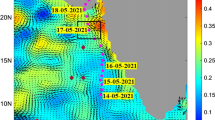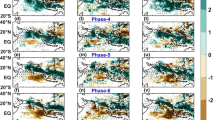Abstract
In this study, the upper ocean and subsurface variability during the different phases of the cyclonic storm ROANU along the western Bay of Bengal (BoB) in May 2016 are investigated by using the moored buoys, Argos, HF radar and satellite datasets in the proximity of the cyclone track. The moored buoy observations recorded a decrease of sea surface temperature (SST) by ~ 1 °C all over the track, whereas increase in salinity by ~ 1.5 PSU was detected along with the highest wind speed of 16 m s−1, pressure drop of 14 hPa and air temperature drop of 4 °C. The cooling at the cyclone centers from the satellite data indicated higher (lower) SST drops when translation speed of the cyclone was low (high) and took more (less) time to recover to its pre-cyclone state in southern (northern) BoB. Mostly, higher SST drop was observed along the right side of the cyclone track. Interestingly, the opposite phenomenon occurred before landfall, where SST drop was higher on the left due to upwelling in the head bay as observed both from wave rider buoy (WRB) at Digha and satellite SST. The WRB near Vizag showed the maximum increase in significant wave heights by ~ 2.4 m during the passage of cyclone. Argos also captured cyclone-induced drop in temperature due to upwelling and entrainment reasonably well. In the southwestern bay, significant upwelling was observed from the Argos with drop in temperature and increase in salinity in the upper layers. However, a strong stratification was observed from Argos in the northwestern BoB due to lesser salinity and higher precipitation. The currents from in situ as well as HF radar datasets measured the increase in current magnitude during the passage of ROANU. Rotary spectral analysis showed strong inertial currents with frequency ~ 2.1 days at BD11 location, with higher amplitudes of the clockwise component during the cyclone period.












Similar content being viewed by others
References
Ali, M. M., Sinha, P., Jain, S., & Mohanty, U. C. (2007). Impact of sea surface height anomalies on cyclone track. Nature Precedings. https://doi.org/10.1038/npre.2007.1001.1.
Balaguru, K., Taraphdar, S., Leung, L. R., et al. (2014). Cyclone-cyclone interactions through the ocean pathway. Geophysical Research Letters, 41(19), 6855–6862.
Behera, S. K., Deo, A. A., & Salvekar, P. S. (1998). Investigation of mixed layer response to Bay of Bengal cyclone using a simple ocean model. Meteorology and Atmospheric Physics, 65, 77–91. https://doi.org/10.1007/BF01030270.
Bender, M. A., Ginis, I., & Kurihara, Y. (1993). Numerical simulations of tropical cyclone–ocean interaction with a high-resolution coupled model. Journal of Geophysical Research, 98, 23245. https://doi.org/10.1029/93JD02370.
Bentamy, A., Grodsky, S. A., Carton, J. A., et al. (2012). Matching ASCAT and QuikSCAT winds. Journal of Geophysical Research: Oceans. https://doi.org/10.1029/2011JC007479.
Black, P.G. (1983). Ocean temperature changes induced by tropical cyclones. Ph.D. Dissertation. The Pennsylvania State University, p. 278.
Black, W. J., & Dickey, T. D. (2008). Observations and analyses of upper ocean responses to tropical storms and hurricanes in the vicinity of Bermuda. Journal of Geophysical Research: Oceans, 113, 1–25. https://doi.org/10.1029/2007JC004358.
Chinthalu, G. R., Seetaramayya, P., Ravichandran, M., & Mahajan, P. N. (2001). Response of the Bay of Bengal to Gopalpur and Paradip super cyclones during 15–31 October 1999. Current Science, 81, 283–291.
Dare, R. A., & McBride, J. L. (2011). Sea surface temperature response to tropical cyclones. Monthly Weather Review, 139, 3798–3808. https://doi.org/10.1175/MWR-D-10-05019.1.
Freilich, M. H., & Vanhoff, B. A. (2006). The accuracy of preliminary WindSat vector wind measurements: Comparisons with NDBC buoys and QuikSCAT. IEEE Transactions on Geoscience and Remote Sensing, 44, 622–637. https://doi.org/10.1109/TGRS.2006.869928.
Girishkumar, M. S., Suprit, K., Chiranjivi, J., et al. (2014). Observed oceanic response to tropical cyclone Jal from a moored buoy in the south-western Bay of Bengal. Ocean Dynamics, 64, 325–335. https://doi.org/10.1007/s10236-014-0689-6.
Gopalakrishna, V. V., Murty, V. S. N., Sarma, M. S., & Sastry, J. S. (1993). Thermal response of upper layers of Bay of Bengal to forcing of a severe cyclonic storm: A case study. Indian J Mar Sci, 11, 8–11.
Hart, R. E., Maue, R. N., & Watson, M. C. (2007). Estimating local memory of tropical cyclones through MPI anomaly evolution. Monthly Weather Review, 135, 3990–4005. https://doi.org/10.1175/2007mwr2038.1.
Houze, R. A., Jr. (2004). Mesoscale convective systems. Reviews of Geophysics, 42, 4003. https://doi.org/10.1029/2004rg000150.
Indian Metrological Department. (2016). Report on cyclonic disturbances over north Indian Ocean during 2016. New Delhi: Regional Specialised Meteorological Center—Tropical Cyclones, India Meteorological Department.
John, M., Jena, B. K., & Sivakholundu, K. M. (2015). Surface current and wave measurement during cyclone Phailin by high frequency radars along the Indian coast. Current Science, 108, 405–409.
Jourdain, N. C., Lengaigne, M., Vialard, J., et al. (2013). Observation-based estimates of surface cooling inhibition by heavy rainfall under tropical cyclones. Journal of Physical Oceanography, 43, 205–221. https://doi.org/10.1175/jpo-d-12-085.1.
Khan, T. M. A., Singh, O. P., & Rahman, M. S. (2000). Recent sea level and sea surface temperature trends along the Bangladesh Coast in relation to the frequency of intense cyclones. Marine Geodesy, 23, 103–116. https://doi.org/10.1080/01490410050030670.
Mandal, S., & Sil, S. (2017). Coastal currents from HF radars along Odisha Coast. Ocean Digest Quarterly Newsletter of the Ocean Society of India, 4, 1–12.
Mandal, S., Sil, S., Gangopadhyay, A., Murty, T., & Swain, D. (2018). On extracting high-frequency tidal variability from HF radar data in the northwestern Bay of Bengal. Journal of Operational Oceanography. https://doi.org/10.1080/1755876X.2018.147957171.
Maneesha, K., Murty, V. S. N., Ravichandran, M., et al. (2012). Upper ocean variability in the Bay of Bengal during the tropical cyclones Nargis and Laila. Progress in Oceanography, 106, 49–61. https://doi.org/10.1016/j.pocean.2012.06.006.
McPhaden, M. J., & Vialard, J. (2009). Ocean-atmosphere interactions during cyclone Nargis. American Geophysical Union Publication, 90, 53–60.
Obasi, G. O. P. (1997). WMO’s programme on tropical cyclone. Mausam, 48, 103–112.
Pothapakula, P. K., Osuri, K. K., Pattanayak, S., et al. (2017). Observational perspective of SST changes during life cycle of tropical cyclones over Bay of Bengal. Natural Hazards, 88, 1769. https://doi.org/10.1007/s11069-017-2945-9.
Prakash, K. R., & Pant, V. (2017). Upper oceanic response to tropical cyclone Phailin in the Bay of Bengal using a coupled atmosphere–ocean model. Ocean Dynamics, 67, 51–64. https://doi.org/10.1007/s10236-016-1020-5.
Prasad, S., Aung, T., & Singh, A. (2009). Analysis of water properties and geostrophic currents in Fiji waters before and after tropical cyclone gene. American Journal of Environmental Sciences, 5(5), 455–460.
Price, J. F. (1981). Upper ocean response to a hurricane. Journal of Physical Oceanography, 11, 153–175.
Rao, R. R. (1987). Further analysis on the thermal response of the upper Bay of Bengal to the forcing of pre-monsoon cyclonic storm and summer monsoon onset during MONEX-79. Mausam, 38, 147–156.
Sengupta, D., Bharath Raj, G., & Anitha, D. S. (2008). Cyclone-induced mixing does not cool SST in the post-monsoon north Bay of Bengal. Atmospheric Science Letters, 9, 1–6. https://doi.org/10.1002/asl.
Shetye, S. R., Shenoi, S. S. C., Gouveia, A. D., Michael, G. S., Sundar, D., & Nampoothiri, G. (1991). Wind-driven coastal upwelling along the western boundary of the Bay of Bengal during the southwest monsoon. Continental Shelf Research, 11, 1397–1408. https://doi.org/10.1016/0278-4343(91)90042-5.
Sil, S., & Chakraborty, A. (2012). The mechanism of the 20 °C isotherm depth oscillations for the Bay of Bengal. Marine Geodesy, 35, 233–245. https://doi.org/10.1080/01490419.2011.637865.
Subrahmanyam, B., Murty, V. S. N., Sharp, R. J., & O’Brien, J. J. (2005). Air–sea coupling during the tropical cyclones in the Indian Ocean: A case study using satellite observations. Pure and Applied Geophysics, 162, 1643–1672. https://doi.org/10.1007/s00024-005-2687-6.
Sun, L., Yang, Y. J., Xian, T., Lu, Z. M., & Fu, Y. F. (2010). Strong enhancement of chlorophyll a concentration by a weak typhoon. Marine Ecology Progress Series, 404, 39–50.
Venkatesan, R., Lix, J. K., Reddy, A. P., & Muthiah, M. A. (2016). Two decades of operating the Indian moored buoy network: significance and impact. Journal of Operational Oceanography, 9, 45–54. https://doi.org/10.1080/1755876X.2016.1182792.
Venkatesan, R., Shamji, V. R., Latha, G., et al. (2013). In situ ocean subsurface time-series measurements from OMNI buoy network in the Bay of Bengal. Current Science, 104, 1166–1177.
Vissa, N. K., Satyanarayana, A. N. V., & Kumar, B. P. (2013). Response of upper ocean and impact of barrier layer on Sidr cyclone induced sea surface cooling. Ocean Science Journal, 48, 279–288. https://doi.org/10.1007/s12601-013-0026-x.
Vissa, N. K., Satyanarayana, A. N. V., & Prasad Kumar, B. (2012). Response of upper ocean during passage of mala cyclone utilizing Argo data. International Journal of Applied Earth Observation and Geoinformation, 14, 149–159. https://doi.org/10.1016/j.jag.2011.08.015.
Wang, J. W., Han, W., & Sriver, R. L. (2012). Impact of tropical cyclones on the ocean heat budget in the Bay of Bengal during 1999: 2. Processes and interpretations. J Geophys Res Ocean. https://doi.org/10.1029/2012jc008373.
Wong, A., Keeley, R., Carval, T. (2009). The Argo Data Management Team, Argo Data Management, Version 2.5.
Yablonsky, R. M., & Ginis, I. (2013). Impact of a warm ocean Eddy’s circulation on hurricane-induced sea surface cooling with implications for hurricane intensity. Monthly Weather Review, 141, 997–1021. https://doi.org/10.1175/MWR-D-12-00248.1.
Acknowledgements
The authors appreciatively acknowledge the financial support given by the Earth System Science Organization (ESSO)—Indian National Centre for Oceanic Information Services (INCOIS), Ministry of Earth Sciences (MoES), and Science and Engineering Research Board (SERB) of the Department of Science and Technology (DST), Government of India. Also, the authors acknowledge Dr. B. K. Jena and his Coastal and Environmental Engineering Group and the Ocean Observation Systems Group, National Institute of Ocean Technology (NIOT), Chennai, for constant monitoring of the HF radars and the moored OMNI buoys, and DMG, INCOIS Hyderabad, India, for making the data availability efficient. The authors are thankful to the editor, associate editor and anonymous reviewers for their valuable comments and suggestions, which have helped to improve the quality of the manuscript. Finally, the authors also acknowledge the Indian Institute of Technology Bhubaneswar (IITBBS) for the infrastructure.
Author information
Authors and Affiliations
Corresponding author
Rights and permissions
About this article
Cite this article
Mandal, S., Sil, S., Shee, A. et al. Upper Ocean and Subsurface Variability in the Bay of Bengal During Cyclone ROANU: A Synergistic View Using In Situ and Satellite Observations. Pure Appl. Geophys. 175, 4605–4624 (2018). https://doi.org/10.1007/s00024-018-1932-8
Received:
Revised:
Accepted:
Published:
Issue Date:
DOI: https://doi.org/10.1007/s00024-018-1932-8




